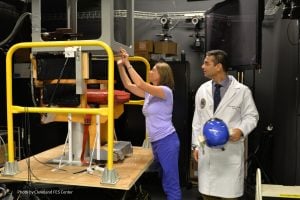Meet Our Researchers
 APDA is proud to support some of the most innovative scientists working in the field of Parkinson’s disease (PD) research. In our continued effort to familiarize you with APDA-funded researchers and their research projects, I would like to introduce you to Dr. Aasef Shaikh MD, PhD, Assistant Professor of Neurology at Case Western Reserve University in Cleveland, Ohio and Staff Neurologist at Cleveland VA Medical Center and University Hospitals.
APDA is proud to support some of the most innovative scientists working in the field of Parkinson’s disease (PD) research. In our continued effort to familiarize you with APDA-funded researchers and their research projects, I would like to introduce you to Dr. Aasef Shaikh MD, PhD, Assistant Professor of Neurology at Case Western Reserve University in Cleveland, Ohio and Staff Neurologist at Cleveland VA Medical Center and University Hospitals.
Dr. Shaikh is the recipient of APDA’s prestigious three-year George C. Cotzias Fellowship for 2018-2021. His research focuses on the complex interactions of various neurologic systems, their effects on gait and balance in PD, and how they can be modified by Deep Brain Stimulation (DBS). The systems that Dr. Shaikh studies include: vision, eye movements, the inner ear/vestibular system, and proprioception.
We asked Dr. Shaikh questions about his research:
Q: What is the overarching goal of your research? What do you hope to find out?
A: The overarching goal of our research program is to develop a DBS-based therapeutic approach to improve balance, gait and postural instability in PD. If we better understand the brain circuitry, we may be able to find the right place to stimulate with DBS to prevent falls, a major problem for many people with PD, which is not adequately addressed with current DBS strategies.
Q: Could you describe how you perform your studies?
A: The first step in our approach is to study patients with PD who have undergone DBS, and understand how they navigate the world. Next, we modify one of their sources of information about their environment, for example, vision. Then we manipulate their DBS parameters to study how the DBS stimulation affects their function. Subsequently, to better understand the mechanism of 
Ours is a multidisciplinary program. We need to access different kinds of expertise to fully understand all the elements that affect balance and postural instability in PD.
We use many different experimental setups in our lab in order to perform our research. We have a unique motion delivery system that measures balance in PD patients. This type of system is normally used by NASA (or other space agencies) to train astronauts. In our lab we have modified this system to study postural control and balance function in PD, critical to preventing falls. We are the only group utilizing such a state of the art system in combination with DBS to understand how DBS can be used to improve balance function in PD.
Q: How do you recruit patients to your study?
A: I am a neurologist and my practice is comprised of patients with various forms of movement disorders, including PD. My patients are my research partners. They help me by volunteering in my studies, allowing me to try to formulate the answers necessary to conquer PD. Sometimes interested volunteers who are not my patients contact me to participate in my studies. I welcome them to visit my laboratory and I appreciate their willingness to volunteer in our research program as study subjects.
Q: If one of our readers wants to participate in your research, what should they do?
A: They can email me at Axs848@case.edu
Q: Can you tell us a little bit about what you have found out so far?
A: In a specific program related to gait and postural instability in PD, we found that DBS modulates important connections between the cerebellum and thalamus to affect balance and gait function. If our research stays consistent, this may provide a new way to think about these deficits, and possibly treat them.
Q: What fuels your passion for your research?
A: Enthusiasm and the support of my patients drives my passion. Talking to patients and knowing their personal experiences about their disease and treatment is critical to finding novel ways to treat their problems. Such conversations fuel my passion for research.
In addition, our research frequently leads us to new questions that we did not previously think to ask. Sometimes that question and its answer lead us in a completely new direction. The process continues, with one set of questions leading to the next, fueling the growth of our research program.
Here is a video that elaborates on Dr. Shaikh’s interdisciplinary program in PD:
Tips and Takeaways
- APDA is proud to fund a myriad of research endeavors and from time to time, A Closer Look will profile one of our researchers so that you can learn more about the exciting research that APDA funds.
- Dr. Aasef Shaikh, APDA’s 2018-2021 George C. Cotzias Fellowship awardee, is studying how various neurologic systems, such as the vision and the vestibular system, affect gait and balance in PD, and how DBS can be modified to improve gait and balance.
- Read more about all of the current research APDA is funding.
